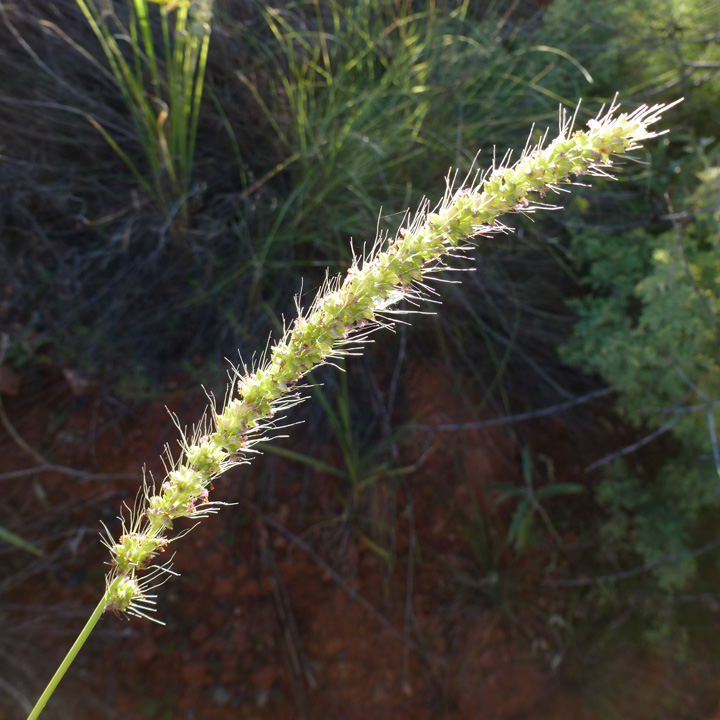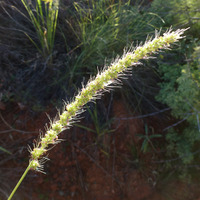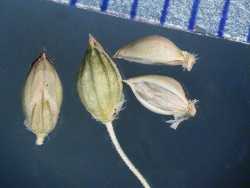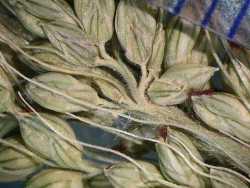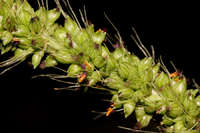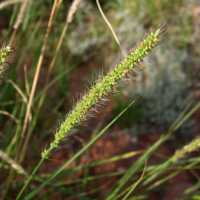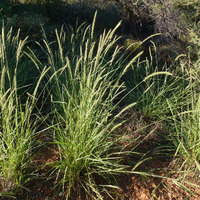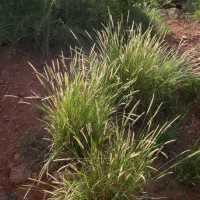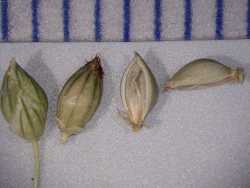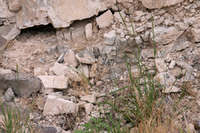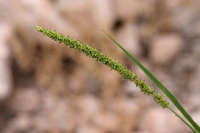Plants perennial; cespitose. Culms 20-100 cm. Sheaths compressed, glabrous, margins villous distally; ligules 1-2.5 mm, ciliate; blades 8-25 cm long, 2-5 mm wide, flat or folded, scabrous on both surfaces. Panicles 6-15 cm, tightly spikelike, pale green; rachises scabrous or villous; bristles usually solitary, 4-15 mm, ascending. Spikelets 2.2-2.8(3) mm, elliptical. Lower glumes about 1/2 as long as the spikelets, 3-veined; upper glumes from 3/4 as long as to equaling the florets, 5-veined; lower lemmas equaling the upper lemmas, 5-veined; lower paleas 1/2-3/4 as long as the upper paleas, lanceolate; upper lemmas apiculate, finely and transversely rugose; upper paleas similar. 2n = 54, 68, 72.
Setaria leucopila grows in the southwestern United States and northern Mexico. It is the most common of the perennial Plains bristlegrasses.
Perennials, Terrestrial, not aquatic, Stems nodes swollen or brittle, Stems erect or ascending, Stems geniculate, decumbent, or lax, sometimes rooting at nodes, Stems caespitose, tufted, or clustered, Stems terete, round in cross section, or polygonal, Stems compressed, flattened, or sulcate, Stem internodes solid or spongy, Stem internodes hollow, Stems with inflorescence less than 1 m tall, Stems, culms, or scapes exceeding basal leaves, Leaves mostly cauline, Leaves conspicuously 2-ranked, distichous, Leaves sheathing at base, Leaf sheath mostly open, or loose, Leaf sheath smooth, glabrous, Leaf sheath or blade keeled, Leaf sheath and blade differentiated, Leaf blades linear, Leaf blades 2-10 mm wide, Leaf blades mostly flat, Leaf blade margins folded, involute, or conduplicate, Leaf blades m ostly glabrous, Leaf blades scabrous, roughened, or wrinkled, Ligule present, Ligule a fringe of hairs, Inflorescence terminal, Inflorescence a contracted panicle, narrowly paniculate, branches appressed or ascending, Inflorescence a dense slender spike-like panicle or raceme, branches contracted, Inflorescence solitary, with 1 spike, fascicle, glomerule, head, or cluster per stem or culm, Inflorescence spike linear or cylindric, several times longer than wide, Peduncle or rachis scabrous or pubescent, often with long hairs, Flowers bisexual, Spikelets pedicellate, Spikelets dorsally compressed or terete, Spikelet less than 3 mm wide, Spikelets with 1 fertile floret, Spikelets with 2 florets, Spikelet with 1 fertile floret and 1-2 sterile florets, Spikelets solitary at rachis nodes, Spikelets all alike and fertille, Spikelets bisexual, Spikelets disarticulating below the glumes, Spikelets all subtended by bristles, Spikelet bristles 1-3, Spikelet bracts bristles not disar ticulating with spikelets, Rachilla or pedicel glabrous, Glumes present, empty bracts, Glumes 2 clearly present, Glumes distinctly unequal, Glumes shorter than adjacent lemma, Glume equal to or longer than spikelet, Glumes 3 nerved, Glumes 4-7 nerved, Lemmas thin, chartaceous, hyaline, cartilaginous, or membranous, Lemma similar in texture to glumes, Lemma becoming indurate, enclosing palea and caryopsis, Lemma 5-7 nerved, Lemma glabrous, Lemma rugose, with cross wrinkles, or roughened, Lemma apex acute or acuminate, Lemma awnless, Lemma margins thin, lying flat, Lemma straight, Palea present, well developed, Palea shorter than lemma, Palea 2 nerved or 2 keeled, Stamens 3, Styles 2-fid, deeply 2-b
Common Name: streambed bristlegrass
Duration: Perennial
Nativity: Native
Lifeform: Graminoid
General: Tufted perennial grass, 20-100 cm, usually pale or glaucous; stems erect or geniculate from cespitose base, compressed, scabrous below panicle and nodes, often pubescent below nodes.
Vegetative: Sheaths compressed-keeled, glabrous except near scabrous summit and keel, villous along upper margins; ligule 1-2.5 mm long, densely ciliate; leaf blades 2-5 mm wide, flat or folded, 8-25 cm long, scabrous on both surfaces or nearly glabrous beneath.
Inflorescence: Densely flowered panicle, 6-15 cm long, pale green, columnar, often interrupted below, the axis scabrous or villous; bristles mostly solitary below each spikelet, 4-15 mm, ascending; spikelets 2-3 mm, elliptical, and 2-flowered, the first floret sterile or staminate, and the second floret fertile; lower glumes about 1/2 as long as the spikelets, 3-veined; upper glumes from 3/4 as long as to equaling the florets, 5-veined; sterile lemma and fertile lemma about equal; fertile lemma apiculate, finely rugose transversely.
Ecology: Found in grasslands and open ground, from 3,000-7,000 ft (914-2134 m); flowers May-October.
Distribution: sw US from AZ and UT east to TX and OK; south to s MEX and disjunct in South America.
Notes: Setaria spp. have inflorescences with short, mostly contracted branches and single-seeded, hard spikelets subtended by persistent bristles that remain on the plant after the spikelets have fallen. S. leucopila is the main perennial Setaria of grasslands in the Southwest and is distinguished by being an often robust, erect perennial to 1 m, with leaves < 5 mm wide, columnar inflorescences 6-15 cm long, and spikelets resembling an elongated hemisphere (elliptical; see pic). S. macrostachya is nearly identical but differs by often being taller, having wider leaves (7-15 mm wide), usually longer inflorescences (10-30 cm) and spikelets which are more rounded on the back (subspherical).
Ethnobotany: Unknown
Etymology: Setaria is from Latin saeta, a bristle or hair; leucopila is from Greek leukos for bright, clear, or white, and Latin pilus, a hair.
Synonyms: Chaetochloa leucophila
Editor: SBuckley 2010, FSCoburn 2014, AHazelton 2015


